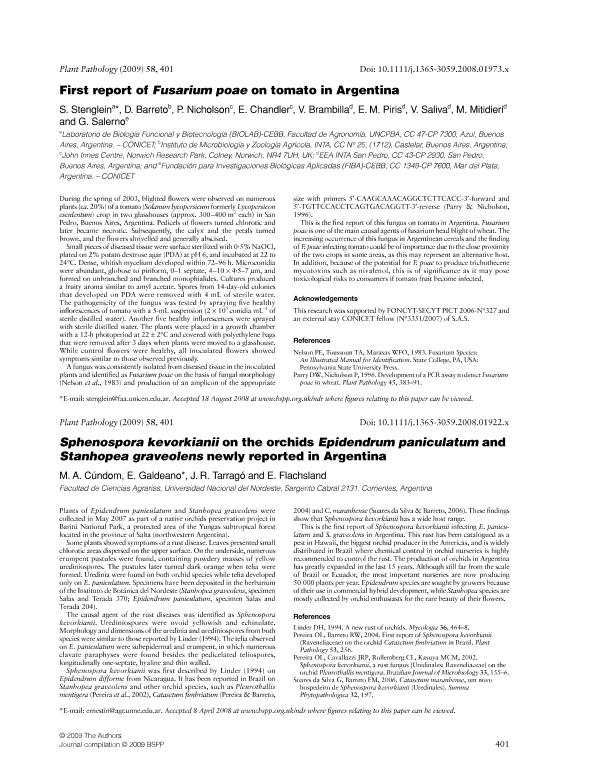Mostrar el registro sencillo del ítem
dc.contributor.author
Stenglein, Sebastian Alberto

dc.contributor.author
Barreto, D.
dc.contributor.author
Nicholson, P.
dc.contributor.author
Chandler, E.
dc.contributor.author
Brambilla, V.
dc.contributor.author
Piris, E. M.
dc.contributor.author
Saliva, V.
dc.contributor.author
Mitidieri, Mariel Silvina

dc.contributor.author
Salerno, Graciela Lidia

dc.date.available
2020-08-25T16:28:35Z
dc.date.issued
2009-12
dc.identifier.citation
Stenglein, Sebastian Alberto; Barreto, D.; Nicholson, P.; Chandler, E.; Brambilla, V.; et al.; First report of Fusarium poae on tomato in Argentina; Wiley Blackwell Publishing, Inc; Plant Pathology; 58; 2; 12-2009; 401-401
dc.identifier.issn
0032-0862
dc.identifier.uri
http://hdl.handle.net/11336/112349
dc.description.abstract
During the spring of 2003, blighted flowers were observed on numerous plants (ca. 20%) of a tomato (Solanum lycopersicum formerly Lycopersicon esculentum) crop in two glasshouses (approx. 300–400 m2 each) in San Pedro, Buenos Aires, Argentina. Pedicels of flowers turned chlorotic and later became necrotic. Subsequently, the calyx and the petals turned brown, and the flowers shrivelled and generally abscised. Small pieces of diseased tissue were surface sterilized with 0·5% NaOCl, plated on 2% potato dextrose agar (PDA) at pH 6, and incubated at 22 to 24°C. Dense, whitish mycelium developed within 72–96 h. Microconidia were abundant, globose to piriform, 0–1 septate, 4–10 × 4·5–7 µm, and formed on unbranched and branched monophialides. Cultures produced a fruity aroma similar to amyl acetate. Spores from 14‐day‐old colonies that developed on PDA were removed with 4 mL of sterile water. The pathogenicity of the fungus was tested by spraying five healthy inflorescences of tomato with a 5‐mL suspension (2 × 105 conidia mL−1 of sterile distilled water). Another five healthy inflorescences were sprayed with sterile distilled water. The plants were placed in a growth chamber with a 12‐h photoperiod at 22 ± 2°C and covered with polyethylene bags that were removed after 3 days when plants were moved to a glasshouse. While control flowers were healthy, all inoculated flowers showed symptoms similar to those observed previously. A fungus was consistently isolated from diseased tissue in the inoculated plants and identified as Fusarium poae on the basis of fungal morphology (Nelson et al., 1983) and production of an amplicon of the appropriate size with primers 5′‐CAAGCAAACAGGCTCTTCACC‐3′‐forward and 5′‐TGTTCCACCTCAGTGACAGGTT‐3′‐reverse (Parry & Nicholson, 1996). This is the first report of this fungus on tomato in Argentina. Fusarium poae is one of the main causal agents of fusarium head blight of wheat. The increasing occurrence of this fungus in Argentinean cereals and the finding of F. poae infecting tomato could be of importance due to the close proximity of the two crops in some areas, as this may represent an alternative host. In addition, because of the potential for F. poae to produce trichothecene mycotoxins such as nivalenol, this is of significance as it may pose toxicological risks to consumers if tomato fruit become infected.
dc.format
application/pdf
dc.language.iso
eng
dc.publisher
Wiley Blackwell Publishing, Inc

dc.rights
info:eu-repo/semantics/openAccess
dc.rights.uri
https://creativecommons.org/licenses/by-nc-sa/2.5/ar/
dc.subject
FUSARIUM POAE
dc.subject
TOMATO
dc.subject.classification
Agronomía, reproducción y protección de plantas

dc.subject.classification
Agricultura, Silvicultura y Pesca

dc.subject.classification
CIENCIAS AGRÍCOLAS

dc.title
First report of Fusarium poae on tomato in Argentina
dc.type
info:eu-repo/semantics/article
dc.type
info:ar-repo/semantics/artículo
dc.type
info:eu-repo/semantics/publishedVersion
dc.date.updated
2020-05-11T18:19:07Z
dc.journal.volume
58
dc.journal.number
2
dc.journal.pagination
401-401
dc.journal.pais
Reino Unido

dc.journal.ciudad
Londres
dc.description.fil
Fil: Stenglein, Sebastian Alberto. Universidad Nacional del Centro de la Provincia de Bueno Aires. Facultad de Agronomía. Laboratorio de Biología Funcional y Biotecnología; Argentina
dc.description.fil
Fil: Barreto, D.. Instituto Nacional de Tecnología Agropecuaria. Centro de Investigación en Ciencias Veterinarias y Agronómicas. Instituto de Microbiología y Zoología Agrícola; Argentina
dc.description.fil
Fil: Nicholson, P.. Norwich Research Park; Reino Unido
dc.description.fil
Fil: Chandler, E.. Norwich Research Park; Reino Unido
dc.description.fil
Fil: Brambilla, V.. Instituto Nacional de Tecnología Agropecuaria. Centro Regional Buenos Aires Norte. Estación Experimental Agropecuaria San Pedro; Argentina
dc.description.fil
Fil: Piris, E. M.. Instituto Nacional de Tecnología Agropecuaria. Centro Regional Buenos Aires Norte. Estación Experimental Agropecuaria San Pedro; Argentina
dc.description.fil
Fil: Saliva, V.. Instituto Nacional de Tecnología Agropecuaria. Centro Regional Buenos Aires Norte. Estación Experimental Agropecuaria San Pedro; Argentina
dc.description.fil
Fil: Mitidieri, Mariel Silvina. Instituto Nacional de Tecnología Agropecuaria. Centro Regional Buenos Aires Norte. Estación Experimental Agropecuaria San Pedro; Argentina
dc.description.fil
Fil: Salerno, Graciela Lidia. Consejo Nacional de Investigaciones Cientificas y Tecnicas. Oficina de Coordinacion Administrativa Pque. Centenario. Instituto de Investigaciones En Biociencias Agricolas y Ambientales. Grupo Vinculado Cent de Est Biodivers y Biotec Mdp- Inba. Fund P/ Invest Biologicas Aplicadas - Mdp | Universidad de Buenos Aires. Facultad de Agronomia. Instituto de Investigaciones En Biociencias Agricolas y Ambientales. Grupo Vinculado Cent de Est Biodivers y Biotec Mdp- Inba. Fund P/ Invest Biologicas Aplicadas - Mdp. ; Argentina; Argentina
dc.journal.title
Plant Pathology

dc.relation.alternativeid
info:eu-repo/semantics/altIdentifier/doi/http://dx.doi.org/10.1111/j.1365-3059.2008.01973.x
dc.relation.alternativeid
info:eu-repo/semantics/altIdentifier/url/https://bsppjournals.onlinelibrary.wiley.com/doi/full/10.1111/j.1365-3059.2008.01973.x
Archivos asociados
